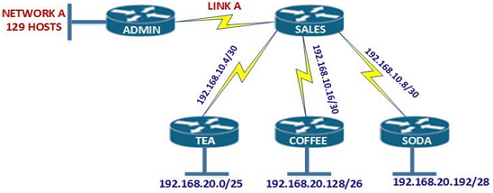In today’s CCNA blog posting, we are going to look at a pretty complex subnetting question that is pretty typical of what you would see on the CCNA 200-301 exam. What you will see here is a networking topology diagram that Cisco will provide to you on the exam with a base scenario of requirements to meet their desired design requirements. The key to this type of exam question is to make sure you read the question very carefully and look for keywords like fewest, least, most, less than, etc. As multiple answers may actually work, but only one will meet the exact requirements of the exam question. So let’s begin below where Cisco sets the stage with the introduction covering the exam question.
Refer to the exhibit. All of the routers in the network are configured with the ip subnet-zero command. Which network addresses should be used for Link A and Network A with the fewest wasted ip addresses? (Choose two)

CCNA Subnetting Question
One of the things that many students are surprised about when they take their first CCNA (Cisco Certified Networking Associate) 200-301 exam is that the questions are not straight forward and simple networking theory. I hear it time and time again from people who thought they could guess their way through a Cisco certification exam. Where that might have been true 10 years ago with some easy multiple choice questions where you could rule out two of the four answer and you had a 50/50 chance; it is no longer like that on today’s Cisco exams. That is why Cisco is one of the premier certification exams out there. So now take a look at the possible answers below and let’s try to determine which answers below are correct. One thing that might help you is to write down the subnet chart on the wipable board that you are given when you enter the testing center. This way you don’t have to figure out the subnetting ranges and masks multiple times on the 10 or so subnetting questions you are bound to receive on the exam. This will save you precious moments that you will need on your exam!
A. Network A – 192.168.13.0/24
B. Network A – 192.168.13.0/25
C. Network A – 192.168.13.128/26
D. Link A – 192.168.10.0/29
E. Link A – 192.168.10.0/30
F. Link A – 192.168.10.2/30
VLSM, CIDR, Subnetting Explanation and Answer Overview
In this question, you need to refer to the topology diagram in the upper left hand corner to note that network A needs 129 hosts. Therefore, we need to determine the correct subnet mask. There is only 1 answer that fits this and it is A. Answer B and C are incorrect since none of them can accommodate all the host IP addresses that are needed in network A. Answer B would give us only 126 hosts and answer C would give us only 62 hosts.
Link A is a point to point link, therefore the appropriate subnet mask is /30 which means both E and F are possibilities. However, answer F is wrong since this is not a network address. Out of D and E, D will give us 6 possible hosts whereas E will give us only 3 possible hosts. Thus answer E wastes the least amount of IPs and thus is correct.
So our correct answers for this exam question are A and E.
Want to really turbo charge your CCNA learning? Look at building your very own CCNA home lab! With your own lab you will be able to see these subnetting concepts and so much more in action. It will not only help you pass your certification exam easily, it will help prepare you for the real world. As passing the exam is only the first part of the equation. Next you will interview and you will want to have a leg up on all the other candidates with real world, hands-on experience that you can speak to in your interview. Just think how much more impressed the hiring manager will be that you took the initiative to invest in yourself. They may even ask what your home lab looks like and you’ll be totally ready to tell them all about it! So if you are worth it, look at investing a few hundred dollars into your education to get that big paying Cisco job!
